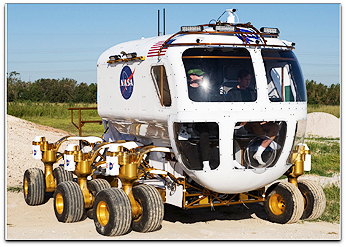NASA is testing out the next generation of lunar rovers, conducting field tests in the Arizona desert. Engineers, astronauts and geologists are driving rovers through terrain similar to the Moon's surface to see if they can perform as advertised when humans return there, hopefully by 2020. One configuration of the rover leaves the crew members free to get on and off the vehicle whenever they like, but they must wear spacesuits at all times to protect them from the lunar environment. The second configuration, the Small Pressurized Rover, (SPR) adds a module on top of the rover's chassis where the crew can sit inside in a shirt-sleeves environment as they drive the vehicle, donning spacesuits whenever they want to get out. Other concepts tested include robot scouts (think R2D2) and improved spacesuits.
[caption id="attachment_20180" align="alignnone" width="580" caption="Another view of the SPR. Credit: NASA"]
[/caption] For the pressurized module, spacesuits hang on the outside of the vehicle, but astronauts can get into the suits from inside the rover.
For the first week of tests, the SPR has been driven on day-long trips to determine how each configuration performed. These have been some of the longest drives the prototype has ever made, but next week the group will step it up another notch or two, by going on a three-day drive through the desert in the SPR to determine how it performs and whether it's comfortable enough for long-duration trips.
NASA's 11th annual Desert RATS (Research and Technology Studies) field tests have two teams of one astronaut and one geologist to test a variety of lunar rover concepts that will help future astronauts explore the moon further than ever before, construct a long-term lunar base and conduct a wealth of science experiments. During the first use of such rovers on the Apollo missions, astronauts completed almost 20 traverses across the surface of the moon. With each successive mission, NASA improved the rovers' capacity, increasing the number and duration of exploration missions astronauts could complete on the lunar surface.
The SPR concept could provide the astronauts' main mode of transportation, and could also allow them the flexibility to work inside of it without the restrictions imposed by spacesuits. The adaptable vehicle features pivoting wheels that enable "crab style" movement to help the rover maneuver through difficult spots. Its cantilevered cockpit does not obstruct the driver's visibility of the terrain ahead. Early concepts provide an exercise ergometer that allow crews to exercise while driving and simultaneously charge the vehicle's batteries. [caption id="attachment_20182" align="alignnone" width="580" caption="Lunar reconnaissance robot. Credit: NASA"]
[/caption] The Mobility Chassis can be configured in an unpressurized rover (UPR) configuration, with astronauts in spacesuits riding in rotating turrets and can also be used without the pressurized module. Astronauts may also ride in the turrets with the SPR in place, minimizing time for suit changes. The modular design will also allow attachment of various tools that may be needed on a particular mission, such as winches, cable reels, backhoes and cranes.
Source:
NASA
 Universe Today
Universe Today
